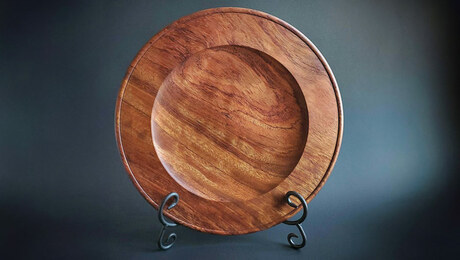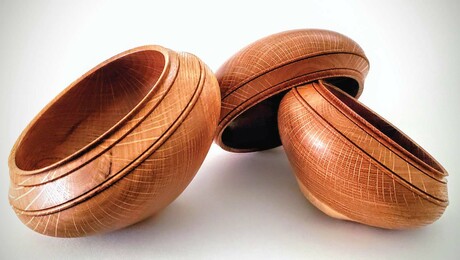Compression Chuck for a Lathe
Shop-built chuck holds bowls tightly, so you can turn a foot
Synopsis: A nicely finished foot on the bottom of a turned bowl is a feature that separates the work of a pro from that of a beginner. The biggest problem, says woodturner Dale Ross, is how to hold the bowl in the lathe. Ross made several compression chucks quickly and inexpensively that handle bowls from 4 in. to 14 in. He explains how compression chucks work and how to make one — from how to make the baseplate and how to turn the jaw plate, platen, and handwheel. He also explains how to use a compression chuck.
A nicely finished foot on the bottom of a turned bowl is one feature separating the work of a pro from that of a beginner. A well-proportioned foot lifts the bowl and gives it a classic look typical of pottery. Turning a foot also eliminates the mounting screw holes on the bottom of the bowl.
The biggest problem with creating a foot or finished bottom is not how to shape it, but how to hold the bowl in the lathe. Turning the foot is the last thing I do, so the outside and inside waste of the bowl has already been cut away and sanded, leaving no place for mounting screws. That’s where my shop-built compression chuck comes in, making it possible to remount the bowl and complete the foot. The real advantage of this system is that once the chucks are made, they can be used over and over again. My set of four chucks will handle bowls ranging from 4 in. to 14 in. dia. The chucks are easy to make and inexpensive, too, because they’re made from plywood and mahogany or poplar scraps.
How a compression chuck works
A compression chuck consists of a flexible jaw plate pressed to a curved baseplate by a platen, as shown in the drawing on p. 77 and the bottom photo on this page. A handwheel is screwed to the outboard end of a threaded rod that passes through the lathe’s headstock. Tightening the handwheel draws the platen toward the headstock and squeezes the jaw plate between the baseplate and the platen, constricting the jaws of the chuck. As the jaws close in, they grab and hold the rim of a bowl.
The jaw plate has a series of evenly stepped ridges to accommodate bowls of varying diameters. The compression chuck shown in the top photo on this page is 11 in. dia. and will accommodate bowls from about 9 in. dia. to 105 ⁄8 in. dia.
From Fine Woodworking #113
For the full article, download the PDF below:
Fine Woodworking Recommended Products

Dividers

Double Sided Tape

Estwing Dead-Blow Mallet





















Log in or create an account to post a comment.
Sign up Log in